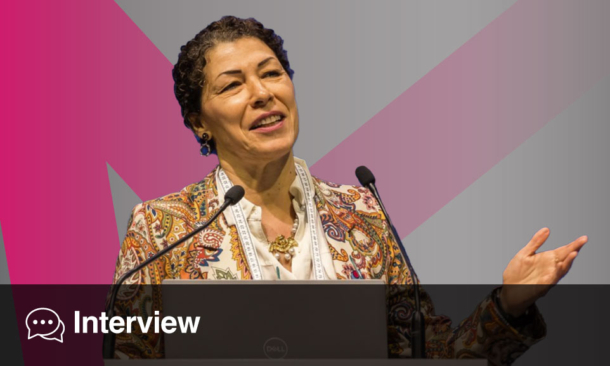Speakers: Nigel Russell,1 Thomas Cluzeau,2 Donal McLornan,1,3 Jeffrey E. Lancet,4 Tara L. Lin5
1. Guy’s and St Thomas’ NHS Foundation Trust, London, UK
2. Centre Hospitalier Universitaire de Nice, Nice, France
3. University College Hospitals, London, UK
4. H. Lee Moffitt Cancer Center and Research Institute, Tampa, Florida, USA
5. University of Kansas Medical Center, Kansas City, Kansas, USA
Disclosure: Prof Russell has received research funding from Amgen, Jazz Pharmaceuticals, and Pfizer; and is a member of the speakers bureau for Jazz Pharmaceuticals, Pfizer, and Novartis. Prof Cluzeau has received clinical research funding from Aprea Therapeutics (PI GFM APR), Novartis, Alexion Pharmaceuticals, Celgene, Amgen, Syros Pharmaceuticals, and Janssen; is on the advisory board for Celgene, AbbVie, Jazz Pharmaceuticals, Roche, and Novartis; has received education grants from Novartis, Amgen, Sanofi, and Astellas Pharma; and has attended international congresses in association with Sanofi, Pfizer, and Celgene. Dr McLornan has received research funding from Novartis and Celgene; honoraria from Jazz Pharmaceuticals; is a member of the speakers bureau for Jazz Pharmaceuticals and Novartis; and is on the advisory board for Jazz Pharmaceuticals and Daiichi Sankyo UK Ltd. Dr Lancet has served as a consultant for Agios Pharmaceuticals, Daiichi Sankyo UK Ltd, Jazz Pharmaceuticals, and Pfizer. Dr Lin has declared no conflicts of interest.
Acknowledgements: Medical writing assistance was provided by Dr Brigitte Scott, MarYas Editorial Services, Suffolk, UK.
Support: This article was funded and reviewed for medical accuracy by Jazz Pharmaceuticals and includes data presented at the 25th European Hematology Association (EHA) Annual Congress held on 11th June 2020. It may include opinions of speakers that do not necessarily reflect those of Jazz Pharmaceuticals.
Citation: EMJ Hematol. 2020;8[1]:39-46.
Meeting Summary:
This symposium and the accompanying poster presentations focussed on high-risk acute myeloid leukaemia (AML). The speakers discussed the recognition of, and treatment options for, patients with high-risk disease based on clinical studies and real-world data. Prof Cluzeau described how high-risk AML is defined as AML with myelodysplasia-related changes (AML-MRC) and therapy-related AML (t-AML). Patients with high-risk AML have a poor prognosis. The approach to AML therapy has not changed substantially in recent years, relying on intensive chemotherapy and allogeneic stem cell transplantation (alloSCT). However, therapies such as Vyxeos® Liposomal ([Jazz Pharmaceuticals, Dublin, Ireland] generic name: CPX-351), the first dual drug, advanced liposomal formulation of daunorubicin and cytarabine, 44 mg/100 mg powder for concentrate for solution for infusion, has been approved in Europe for the treatment of newly diagnosed AML-MRC or t-AML. Prof Russell explained that long-term survival is achievable and alloSCT is the treatment of choice, with early recognition of high-risk disease and optimisation of induction therapy enabling more patients in complete remission (CR) access to alloSCT. As pretransplant minimal residual disease (MRD) status is an important determinant of transplant outcome, MRD measurements postinduction can help identify high-risk patients who are otherwise in CR and may benefit from alloSCT. Dr McLornan highlighted that identifying high-risk features of AML at diagnosis is mandatory for prognosis and therapeutic stratification. Long-term data with Vyxeos Liposomal in the 301 Phase III study confirmed significant improvements in overall survival (OS), including post-transplant. The exploratory, post hoc analysis from the 301-study presented by Dr Lin et al. showed that Vyxeos Liposomal improved median OS versus the 7+3 regimen in patients who achieved CR, or CR with incomplete haematologic recovery (CRi) but did not undergo alloSCT. The 5-year results from the 301 study presented by Dr Lancet et al. showed that improved OS with Vyxeos Liposomal versus the 7+3 regimen was maintained in the overall study population, in patients who achieved CR or CRi and in those who underwent alloSCT. Thus, Vyxeos Liposomal contributed to long-term remission and survival in older patients with newly diagnosed high-risk AML.
Introduction
This symposium focussed on the recognition of, and treatment options for, high-risk AML. Prof Cluzeau considered universal or targeted treatment and where the focus should be, Prof Russell addressed whether high-risk AML can be cured, and Dr McLornan discussed laying the foundations for long-term remission.
Universal or Targeted Treatment of Acute Myeloid Leukaemia: Where Should the Focus Be?
Professor Thomas Cluzeau
Prof Cluzeau explained that high-risk AML is defined by the 2016 World Health Organization (WHO) classification as AML with MRC and therapy-related myeloid neoplasms.1 Approximately one-third (24–35%) of all AML cases are AML-MRC and this is predominantly observed in elderly patients.2 AML-MRC is defined as the absence of both prior cytotoxic therapy for an unrelated disease and recurring cytogenetic abnormality.1,3
Three entities for AML-MRC have been identified.1,3 Firstly, AML post-myelodysplastic syndrome (MDS) or post-MDS/myeloproliferative neoplasm (MPN) is defined by prior MDS1 or prior MDS/MPN,1 with at least 6 months of prior disease history of MDS or MDS/MPN (Cluzeau T., personal clinical experience). Secondly, for de novo AML with MDS-related cytogenetic abnormalities,1 the WHO classification gives a list of cytogenetic abnormalities sufficient to diagnose AML-MRC when ≥20% peripheral blood or bone marrow blasts are present and prior therapy has been excluded. The list includes complex karyotype (three or more abnormalities), unbalanced abnormalities, and balanced abnormalities. Thirdly, in AML with multilineage dysplasia, dysplasia must be present in >50% of cells in at least two bone marrow cell lines and no NPM1 mutation or biallelic CEBPA mutation.1
Approximately 7% of all cases of AML are t-AML.4 Risk for t-AML is associated with alkylating agent, radiation therapy, and topoisomerase II inhibitor treatment.
Prof Cluzeau described that AML-MRC had significantly reduced OS and progression-free survival and lowered CR rate compared with other forms of AML (p=0.001).5 In t-AML with a higher prevalence of TP53 mutations and a complex karyotype, prognosis was relatively poor.6 Secondary AML (s-AML) without MDS also had a poor prognosis; t-AML and s-AML (secondary to MDS) had similar prognoses, and all three were associated with a poorer prognosis than de novo AML.7
Prof Cluzeau reviewed the European Leukemia Net (ELN) treatment option recommendations for the high-risk AML-MRC and t-AML subgroups.4 Treatment for patients who are eligible for intensive chemotherapy is based on induction therapy combining anthracycline and cytarabine, followed by consolidation therapy using chemotherapy or chemotherapy plus alloSCT in patients with intermediate-risk or adverse-risk genetics. For patients who are not eligible for intensive chemotherapy, agents such as azacitidine and decitabine are usually recommended, but low-dose cytarabine or best supportive care can be used in some patients.
Four therapeutic regimens for AML have been approved by the European Medicines Agency (EMA): Vyxeos Liposomal (daunorubicin and cytarabine 44 mg/100 mg; approved August 2018)8 as intensive chemotherapy and Rydapt® ([Novartis Pharmaceuticals Corporation, Basel, Switzerland] generic name: midostaurin; September 2017),9 Mylotarg™ ([Pfizer Inc., New York City, New York, USA] generic name: gemtuzumab ozogamicin; April 2018),10 and Xospata® ([Astellas Pharma, Tokyo, Japan] generic name: gilteritinib; October 2019)11 as targeted therapy.
Prof Cluzeau introduced Vyxeos Liposomal as a therapeutic option in AML-MRC and t-AML, presenting the improved median OS versus the 7+3 cytarabine/daunorubicin regimen, including a significant increase in median OS in patients who underwent alloSCT.12
Prof Cluzeau concluded that patients with high-risk AML, defined as AML-MRC or t-AML, have a poor prognosis.7 The general approach to AML therapy has not changed substantially in recent years, relying on intensive chemotherapy and alloSCT;4 however, therapies have been approved in Europe for the treatment of specific patient subgroups.9,11 Tailoring treatment through identification of high-risk groups such as AML-MRC and t-AML has a beneficial
therapeutic impact.12
Can High-Risk Acute Myeloid Leukaemia Be Cured?
Professor Nigel Russell
Prof Russell explained that the prognosis and relative survival of patients with high-risk AML becomes progressively worse with age, particularly in patients aged >65 years for whom 5-year relative survival is <20%.13 High-risk AML can be recognised at diagnosis in patients who have an adverse risk karyotype4 or adverse genomics4,14 and in patients with a history of s-AML,4 previous antecedent myeloid dysplasia, or t-AML. High-risk status may be indicated after first induction, with the presence of an adverse genotype or primary refractory disease.14 Following second induction, high risk is indicated in patients who have not achieved CR or CR with CRi, and those who have MRD.14 Haematological or molecular relapse also indicates high risk.14
Prof Russell outlined recent experience in the UK of the National Cancer Research Institute (NCRI) trials in younger patients (aged 15−59 years) with high-risk AML, focussing on patients with adverse-risk cytogenetics, which is one of the hallmarks of high-risk disease. Examining sequential trials (AML 10 [1988−1994], AML 12 [1994−2002], AML 15 [2002−2009], and AML 17 [2009−2016]) showed the improving prognosis for these patients; however, <20% of patients were cured in the follow-up period to 2015.15
The strategy for high-risk AML in the UK NCRI trials included recognising high-risk patients early,4 rapid diagnostics, cytogenetics and mutational analysis,15 and using MRD both as an early response indicator of risk status and an early signal of impending relapse.4,15 Prof Russell considered the challenge of high-risk AML as three-fold. Firstly, improving pretransplant chemotherapy could reduce post-transplant relapse rate.16 Secondly, better treatment could deliver more patients to transplant who otherwise might not have remitted or relapsed before undergoing alloSCT.16 Thirdly, more effective treatments are needed for patients for whom alloSCT is not an option.4,15
In patients with NPM1mut AML, MRD measurement post-course 2 can identify high-risk disease.17 Postinduction MRD in peripheral blood also predicts outcome and benefit from alloSCT in NPM1mut AML.18 Furthermore, pretransplant MRD measurement can predict patients at high risk of relapse. Presence of MRD in patients who have achieved CR is associated with similarly poor outcomes with patients who have active disease pre-alloSCT, showing the importance of absence of MRD prior to alloSCT.19-21 Pre-alloSCT MRD transcript measurements can predict post-transplant outcome.22
Prof Russell concluded that long-term survival is achievable in high-risk AML and that alloSCT is the treatment of choice. Early recognition of high-risk disease and optimising induction therapy enables more patients to get to alloSCT in CR. Furthermore, MRD measurements postinduction can help identify high-risk patients who are otherwise in CR who may benefit from alloSCT.
Laying the Foundations for Long-Term Remission in High-Risk Acute Myeloid Leukaemia
Doctor Donal McLornan
Dr McLornan commented that advances in the understanding of the heterogeneity and molecular and cytogenetic knowledge of AML are increasingly used to guide therapeutic decisions. The goal of treatment in AML is to attain and maintain a first CR. AlloSCT is often used as postremission therapy for patients with normal and unfavourable karyotypes. The 10-year outcome of patients with AML not treated with alloSCT at a first CR is poor.23
The standard approaches to intensive therapy for AML for the last 45+ years have involved a 7+3 regimen.24 As introduced by Prof Cluzeau, however, four novel drug regimens have been approved by the EMA: Vyxeos Liposomal,8 Rydapt,9 Mylotarg,10 and Xospata.11 Vyxeos Liposomal is the first licensed dual drug, advanced liposomal formulation of a fixed 1:5 molar ratio of daunorubicin and cytarabine, and is designed to optimise drug delivery to improve efficacy.8,12,25,26 It is indicated for the treatment of adults with newly diagnosed AML-MRC or t-AML.8
Study 301 was a multicentre, randomised, open-label, Phase III study to compare Vyxeos Liposomal versus the 7+3 regimen in older adults with newly diagnosed high-risk/s-AML.27-29 Key eligibility criteria were previously untreated AML, aged 60−75 years, ability to tolerate intensive AML chemotherapy, and Eastern Cooperative Oncology Group (ECOG) performance status (PS) 0–2. Patients received 1–2 cycles of induction, and those who achieved CR or CRi were allowed consolidation for 1–2 cycles. Primary and secondary endpoints were standard for a Phase III trial looking at remission, survival, and safety. A total of 309 patients were enrolled, with a mean age of 68 years, PS was mostly 0 or 1 and, as expected, cytogenetic risk groups were predominantly intermediate or poor; one in five patients in both cohorts had t-AML.12
In the primary endpoint analysis, Vyxeos Liposomal significantly increased median OS versus the 7+3 regimen (median follow-up: 20.7 months).12,30 Median (95% confidence interval [CI]) OS was 9.56 (6.60–11.86) months for Vyxeos Liposomal versus 5.95 (4.99–7.75) months for the 7+3 regimen (p=0.003). There was a 31% reduction in risk of death for patients treated with Vyxeos Liposomal versus the 7+3 regimen (hazard ratio [HR]: 0.69; 95% CI: 0.52–0.90; p=0.003).12
There were significantly greater CR rates with Vyxeos Liposomal versus the 7+3 regimen (37% versus 26%, respectively; odds ratio [OR]: 1.69; 95% CI: 1.03–2.78; 2-sided p=0.040) and significantly greater overall remission rates (CR+CRi) versus the 7+3 regimen (48% versus 33%, respectively; OR: 1.77; 95% CI: 1.11–2.81; 2-sided p=0.016).12 Overall remission rate (CR+CRi) after one induction cycle was 55.2% (58/105) with Vyxeos Liposomal versus 34.0% (34/100) with the 7+3 regimen.
Early mortality rates were lower with Vyxeos Liposomal than with the 7+3 regimen.12,31 Sixty-day mortality caused by adverse events (AE) was comparable for Vyxeos Liposomal and the 7+3 regimen (10.4% versus 9.9%, respectively), and persistent or progressive disease caused this to be markedly lower for Vyxeos Liposomal than the 7+3 regimen (3.3% versus 11.3%, respectively).31 Similar types of AE were recorded for the two treatments and were experienced by similar proportions of patients in each cohort.12
In the Vyxeos Liposomal arm, 49 and 23 patients underwent consolidation 1 and 2, respectively, compared with 32 and 12 patients, respectively, for the 7+3/5+2 regimen.32 Importantly, from a physician and hospital perspective, 51% and 61% of patients received Vyxeos Liposomal consolidation 1 and 2 as an outpatient, respectively.32
Continued therapy with Vyxeos Liposomal throughout induction and consolidation improved OS compared with the 7+3/5+2 regimen. Median (95% CI) OS favoured Vyxeos Liposomal at 25.43 (12.35–not reached) months compared with 8.53 (5.68–15.21) months for the 7+3/5+2 regimen.32
A greater proportion of patients received alloSCT following Vyxeos Liposomal compared with the 7+3 regimen (52/153, 34% versus 39/156, 25%, respectively; 2-sided p=0.098).12 The study arms were similar, but more patients were ≥70 years in the Vyxeos Liposomal arm (16/52, 31%) versus the 7+3 arm (6/39, 15%) and more patients on 7+3 required salvage therapy pretransplant (12/39, 31% versus 5/52, 10%, respectively).12 Median OS landmarked from the date of alloSCT was not reached for Vyxeos Liposomal, compared with 10.25 (95% CI: 6.21–16.69) months for the 7+3 regimen. There were 53% fewer deaths within 100 days of transplant in those who received Vyxeos Liposomal versus the 7+3 regimen.33
The total number of patients achieving CR+CRi following induction was 73/153 (48%) with Vyxeos Liposomal versus 52/156 (33%) with the 7+3 regimen (p=0.016) and for CR was 37% versus 26%, respectively (p=0.040). These data equate to improved OS: median OS was longer with Vyxeos Liposomal (25.43; 95% CI: 13.01–not reached) versus the 7+3 regimen (10.41; 95% CI: 7.82–15.21) in patients who achieved CR or CRi.34 Amongst patients who achieved CR or CRi and underwent alloSCT, median OS landmarked from the date of alloSCT was not reached for Vyxeos Liposomal and was 11.65 months for the 7+3 regimen (HR: 0.42; 95% CI: 0.20–0.86).34 Results for patients who achieved CR or CRi but did not undergo alloSCT are presented below.27
Dr McLornan shared the 5-year final results of study 301, which were presented at the American Society of Clinical Oncology (ASCO) Annual Meeting and the European Hematology Association (EHA) Annual Congress, showing that the improved median OS with Vyxeos Liposomal versus the 7+3 regimen seen at 3 years was maintained (9.33 versus 5.95 months, respectively). Notably, for patients who underwent alloSCT with OS landmarked from the time of transplant, survival rate was 52% for Vyxeos Liposomal versus not estimable for the 7+3 regimen.28,29 Dr McLornan emphasised that over one-half of patients who received Vyxeos Liposomal and then underwent alloSCT were still alive 5 years later, and that median OS landmarked from the date of alloSCT was not reached for Vyxeos Liposomal versus 10.25 months for the 7+3 regimen; therefore, stratification of therapy upfront is an optimal approach.
Dr McLornan concluded that identifying high-risk features of AML at diagnosis is mandatory for prognosis and correct therapeutic stratification. Long-term data with Vyxeos Liposomal in the 301 study28,29 confirmed significant improvements in OS, including post-transplant.
Outcomes in Older Patients with High-Risk/Secondary Acute Myeloid Leukaemia Who Achieved Remission with CPX-351 Versus the 7+3 Regimen but Did Not Undergo Transplant: Phase III Exploratory Analysis
Doctor Tara L. Lin et al.
This exploratory, post hoc analysis of the 301 Phase III study evaluated outcomes in the subgroup of patients who achieved CR or CRi with CPX-351 versus the 7+3 regimen, but did not undergo alloSCT.27 Patient baseline characteristics were generally balanced between treatment arms; however, in the CPX-351 arm, there were more males and patients with a PS of 1, but fewer patients with antecedent MDS, hypomethylating agent exposure, and PS 0 or 2, versus the 7+3 arm. Remission (CR+CRi) following induction was achieved in 73/153 (48%) patients with CPX-351 versus 52/156 (33%) with the 7+3 regimen. Amongst those attaining CR or CRi, 33/73 (45%) with CPX-351 and 28/52 (54%) with the 7+3 regimen did not subsequently undergo alloSCT.
Median OS (months) was longer with CPX-351 (14.72; 95% CI: 9.33–25.43) versus the 7+3 arm (7.59; 95% CI: 4.86–10.87) (HR: 0.57; 95% CI: 0.31–1.03) in patients who achieved CR or CRi but did not undergo alloSCT. Among patients aged 60−69 years, median OS was 15.74 months with CPX-351 versus 7.36 months with the 7+3 arm (HR: 0.53; 95% CI: 0.23–1.22) and among patients aged 70−75 years, median OS was 12.19 months with CPX-351 versus 8.41 months with the 7+3 regimen (HR: 0.47; 95% CI: 0.19–1.21).
Median time to recovery of neutrophils and platelets was longer with CPX-351 than with the 7+3 arm (35.0 and 36.0 days versus 29.0 and 28.5 days, respectively).
The AE profile for CPX-351 was generally similar to that of the 7+3 regimen, with febrile neutropenia, nausea, constipation, and diarrhoea being the most common AE.
The authors concluded that CPX-351 improved median OS versus the 7+3 regimen, irrespective of age in patients who achieved CR or CRi but did not undergo alloSCT, indicating a benefit, and potentially deeper response, with CPX-351 treatment in this subgroup.
Five-Year Results of a Phase III Study of CPX-351 Versus the 7+3 Regimen in Older Adults with Newly Diagnosed High-Risk/Secondary Acute Myeloid Leukaemia
Doctor Jeffrey E. Lancet et al.
Outcomes for the treatment of AML with the 7+3 regimen are particularly poor for older adults and those with high-risk-AML.7,35,36 This prospectively planned, final follow-up of the 301 Phase III study evaluated patients until death or up to 5 years following randomisation to assess the longevity of the results, including significantly improved median OS, observed at the primary endpoint analysis.12
The final 5-year follow-up results (median follow-up: 60.65 months) from the 301 Phase III study (previously presented at the ASCO 2020 Annual Congress)28 showed that improved median OS with CPX-351 versus the 7+3 regimen was maintained (9.33 versus 5.95 months, respectively; Kaplan–Meier OS curves plateaued at around 30 months), with an HR (0.70; 95% CI: 0.55–0.91) that was consistent with the previous primary endpoint analysis (0.69; 95% CI: 0.52–0.90)12 and thus maintained for up to 5 years.28,29 The Kaplan–Meier estimated survival rates were higher for CPX-351 versus the 7+3 arm at 3 years (21% versus 9%, respectively) and 5 years (18% versus 8%, respectively).
A total of 53/153 (35%) and 39/156 (25%) of patients in the CPX-351 and 7+3 arms, respectively, underwent alloSCT. Median OS landmarked from the date of alloSCT was not reached for CPX-351 versus 10.25 months for the 7+3 regimen. The Kaplan–Meier-estimated survival rate landmarked from the date of transplant was 52% at 5 years for patients treated with CPX-351.
CR or CRi was achieved by 73 (48%) patients with CPX-351 and 52 (33%) patients with the 7+3 regimen. Among these patients, median OS was longer with CPX-351 versus the 7+3 regimen and the Kaplan–Meier-estimated survival rate was higher for CPX-351 versus the 7+3 arm at 3 and 5 years. The authors concluded that improved OS with CPX-351 versus the 7+3 regimen was maintained at 5 years in the overall study population, in patients who achieved CR or CRi, and in those who underwent alloSCT.
Questions and Answers
Q: What Were the Key Results from Your Analysis of the Early Experience with Vyxeos Liposomal in France?
Prof Cluzeau highlighted the good safety profile of Vyxeos Liposomal, with less gastrointestinal and skin toxicity and alopecia than observed with the 7+3 regimen, and the increase in haematological toxicity was manageable.37 There was a good CR rate and 72% of patients in CR had MRD <10-3, indicating a deep response. Median OS in patients who underwent alloSCT was not reached.
Q: What Were the Key Results from the 5-Year Follow-Up of Vyxeos Liposomal Versus the 7+3 Regimen in Older Adults with Newly Diagnosed High-Risk/Secondary Acute Myeloid Leukaemia?
Prof Russell explained that the survival advantage observed at 3 years with Vyxeos Liposomal was maintained, with a plateau from 3 to 5 years.28,29 Median OS was significantly improved with Vyxeos Liposomal versus the 7+3 regimen, more patients achieved remission and underwent alloSCT and more patients went into remission post-alloSCT.
Q: What Does This Mean for Treatment of Newly Diagnosed High-Risk Acute Myeloid Leukaemia?
Dr McLornan emphasised correct therapeutic stratification upfront for the patient and the improved OS with Vyxeos Liposomal versus the 7+3 regimen, including post-transplant, with equivalent safety. Historically, remission rates are poor in this subgroup. Now, more patients are receiving alloSCT and survival >1 year is observed in patients who do not undergo alloSCT.
Conclusion
In conclusion, high-risk AML is “curable” with early recognition and correct therapeutic stratification upfront. Vyxeos Liposomal contributes to long-term remission and survival in older patients with newly diagnosed high-risk-AML. Integration of novel chemotherapy, targeted agents, and immunotherapeutic platforms is the future in transplantation and will improve patient survival. Further prospective studies38 and new approaches are needed to target MRD both pre- and post-alloSCT to optimise outcomes for patients with high-risk AML.







